A Comprehensive Report on ASDA CEO's Management Style and Leadership
VerifiedAdded on 2022/12/28
|13
|3897
|67
Report
AI Summary
This report provides a comprehensive analysis of the management style of the CEO of ASDA, a major British supermarket chain. It begins with an introduction to organizational theory and practices, setting the context for examining the CEO's leadership approaches. The main body of the report delves into various aspects of the CEO's management style, including transformational, autocratic, and participative styles, and identifies the management principles and functions employed. It also analyzes the steps taken by the CEO to change the organizational structure to achieve high performance, focusing on strategies like developing a consumer-focused culture and adapting to market trends. Furthermore, the report explores the CEO's leadership style to enhance organizational effectiveness, highlighting democratic, bureaucratic, transactional, and laissez-faire approaches. The analysis extends to the effects of power, influence, and conflict within ASDA, including Pondy's theory of conflict. The report also discusses different types of motivation used in ASDA and supports its arguments with relevant corporate examples and literature, concluding with recommendations.
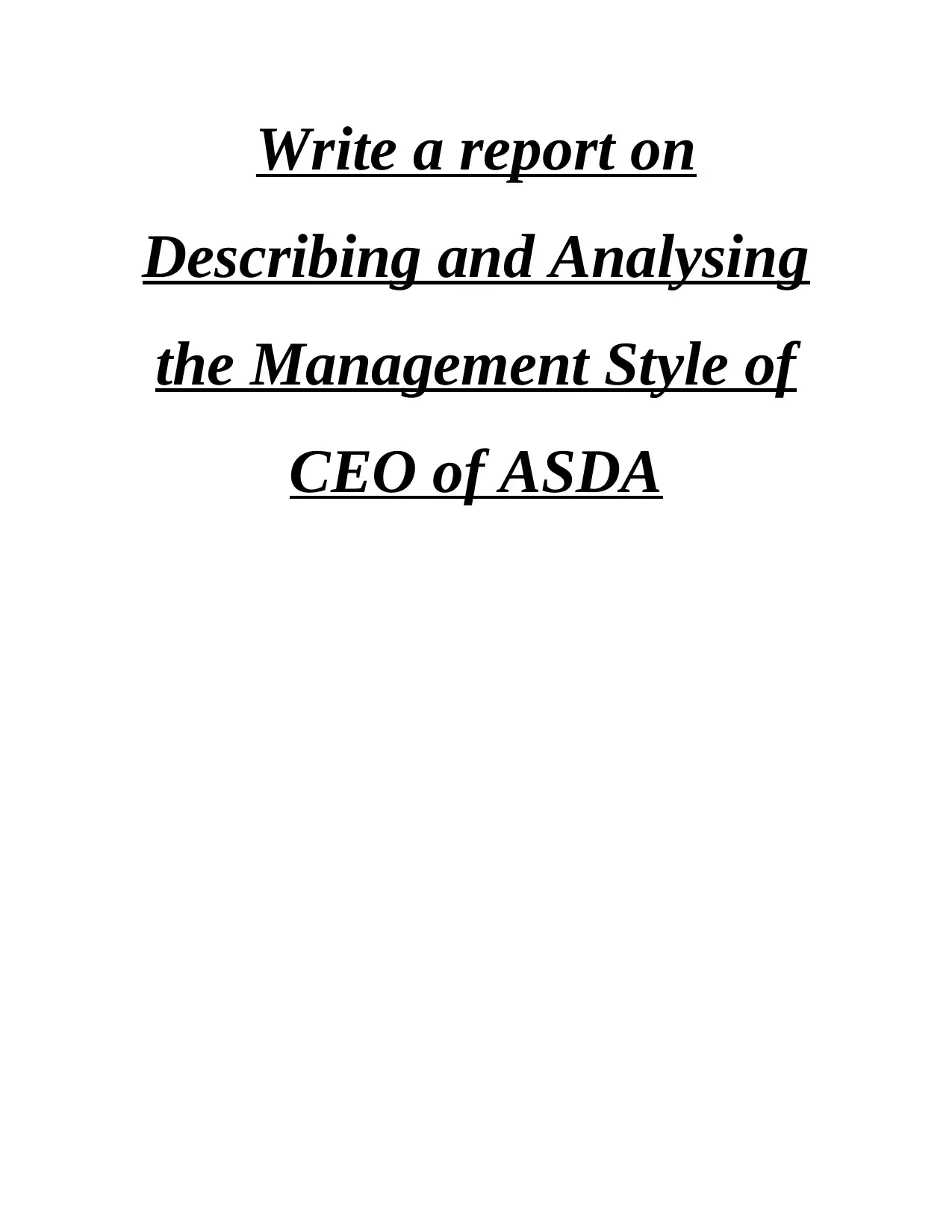
Write a report on
Describing and Analysing
the Management Style of
CEO of ASDA
Describing and Analysing
the Management Style of
CEO of ASDA
Paraphrase This Document
Need a fresh take? Get an instant paraphrase of this document with our AI Paraphraser
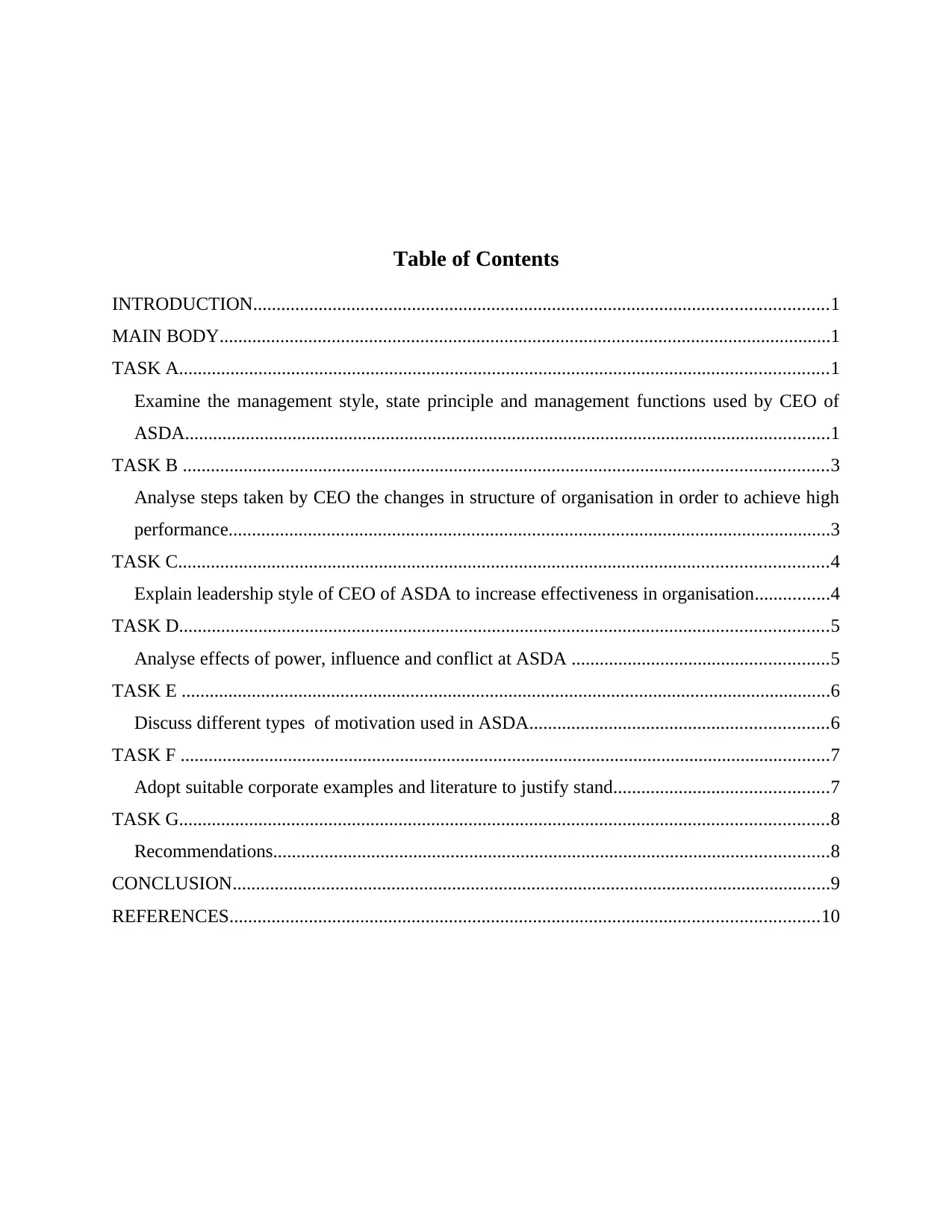
Table of Contents
INTRODUCTION...........................................................................................................................1
MAIN BODY...................................................................................................................................1
TASK A...........................................................................................................................................1
Examine the management style, state principle and management functions used by CEO of
ASDA..........................................................................................................................................1
TASK B ..........................................................................................................................................3
Analyse steps taken by CEO the changes in structure of organisation in order to achieve high
performance.................................................................................................................................3
TASK C...........................................................................................................................................4
Explain leadership style of CEO of ASDA to increase effectiveness in organisation................4
TASK D...........................................................................................................................................5
Analyse effects of power, influence and conflict at ASDA .......................................................5
TASK E ...........................................................................................................................................6
Discuss different types of motivation used in ASDA................................................................6
TASK F ...........................................................................................................................................7
Adopt suitable corporate examples and literature to justify stand..............................................7
TASK G...........................................................................................................................................8
Recommendations.......................................................................................................................8
CONCLUSION................................................................................................................................9
REFERENCES..............................................................................................................................10
INTRODUCTION...........................................................................................................................1
MAIN BODY...................................................................................................................................1
TASK A...........................................................................................................................................1
Examine the management style, state principle and management functions used by CEO of
ASDA..........................................................................................................................................1
TASK B ..........................................................................................................................................3
Analyse steps taken by CEO the changes in structure of organisation in order to achieve high
performance.................................................................................................................................3
TASK C...........................................................................................................................................4
Explain leadership style of CEO of ASDA to increase effectiveness in organisation................4
TASK D...........................................................................................................................................5
Analyse effects of power, influence and conflict at ASDA .......................................................5
TASK E ...........................................................................................................................................6
Discuss different types of motivation used in ASDA................................................................6
TASK F ...........................................................................................................................................7
Adopt suitable corporate examples and literature to justify stand..............................................7
TASK G...........................................................................................................................................8
Recommendations.......................................................................................................................8
CONCLUSION................................................................................................................................9
REFERENCES..............................................................................................................................10

⊘ This is a preview!⊘
Do you want full access?
Subscribe today to unlock all pages.

Trusted by 1+ million students worldwide
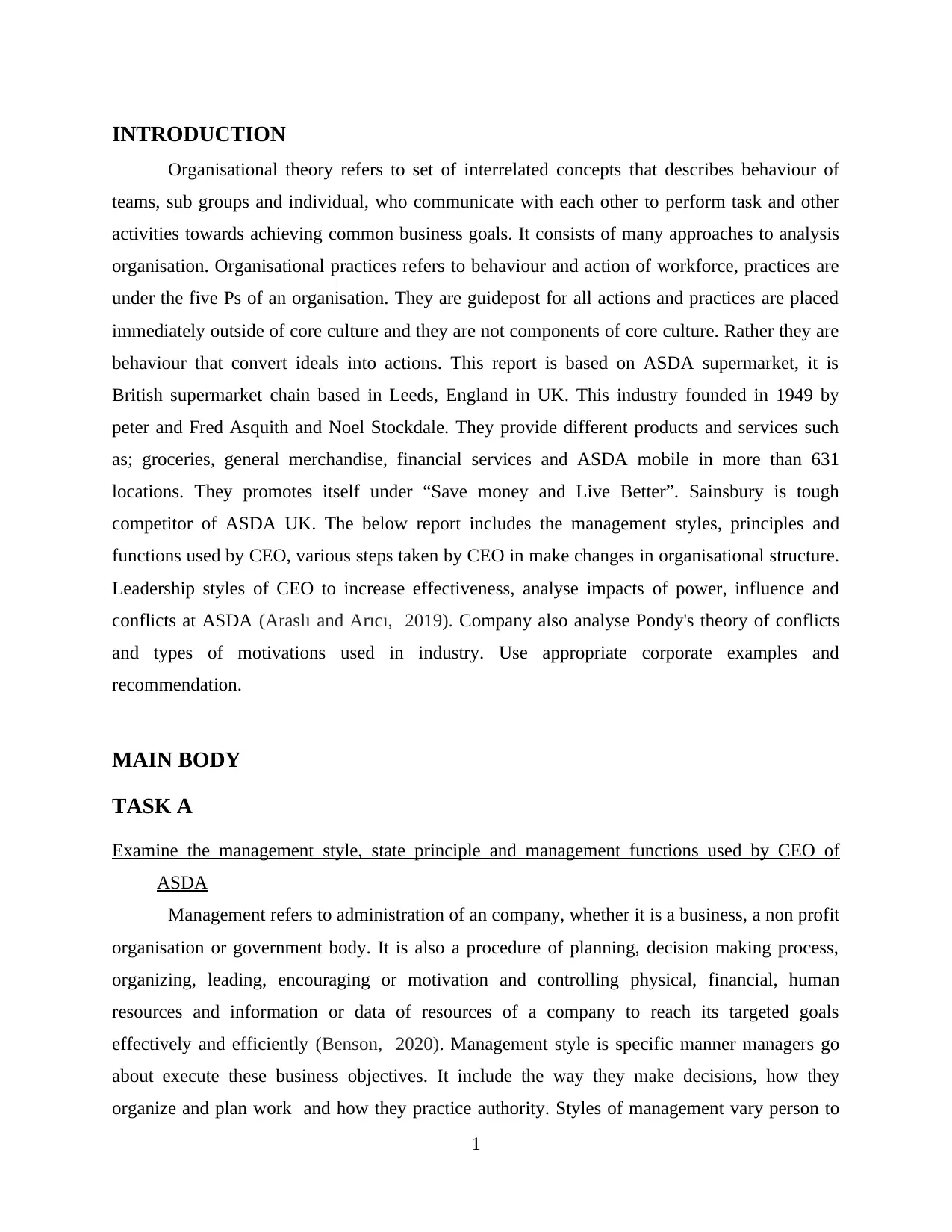
INTRODUCTION
Organisational theory refers to set of interrelated concepts that describes behaviour of
teams, sub groups and individual, who communicate with each other to perform task and other
activities towards achieving common business goals. It consists of many approaches to analysis
organisation. Organisational practices refers to behaviour and action of workforce, practices are
under the five Ps of an organisation. They are guidepost for all actions and practices are placed
immediately outside of core culture and they are not components of core culture. Rather they are
behaviour that convert ideals into actions. This report is based on ASDA supermarket, it is
British supermarket chain based in Leeds, England in UK. This industry founded in 1949 by
peter and Fred Asquith and Noel Stockdale. They provide different products and services such
as; groceries, general merchandise, financial services and ASDA mobile in more than 631
locations. They promotes itself under “Save money and Live Better”. Sainsbury is tough
competitor of ASDA UK. The below report includes the management styles, principles and
functions used by CEO, various steps taken by CEO in make changes in organisational structure.
Leadership styles of CEO to increase effectiveness, analyse impacts of power, influence and
conflicts at ASDA (Araslı and Arıcı, 2019). Company also analyse Pondy's theory of conflicts
and types of motivations used in industry. Use appropriate corporate examples and
recommendation.
MAIN BODY
TASK A
Examine the management style, state principle and management functions used by CEO of
ASDA
Management refers to administration of an company, whether it is a business, a non profit
organisation or government body. It is also a procedure of planning, decision making process,
organizing, leading, encouraging or motivation and controlling physical, financial, human
resources and information or data of resources of a company to reach its targeted goals
effectively and efficiently (Benson, 2020). Management style is specific manner managers go
about execute these business objectives. It include the way they make decisions, how they
organize and plan work and how they practice authority. Styles of management vary person to
1
Organisational theory refers to set of interrelated concepts that describes behaviour of
teams, sub groups and individual, who communicate with each other to perform task and other
activities towards achieving common business goals. It consists of many approaches to analysis
organisation. Organisational practices refers to behaviour and action of workforce, practices are
under the five Ps of an organisation. They are guidepost for all actions and practices are placed
immediately outside of core culture and they are not components of core culture. Rather they are
behaviour that convert ideals into actions. This report is based on ASDA supermarket, it is
British supermarket chain based in Leeds, England in UK. This industry founded in 1949 by
peter and Fred Asquith and Noel Stockdale. They provide different products and services such
as; groceries, general merchandise, financial services and ASDA mobile in more than 631
locations. They promotes itself under “Save money and Live Better”. Sainsbury is tough
competitor of ASDA UK. The below report includes the management styles, principles and
functions used by CEO, various steps taken by CEO in make changes in organisational structure.
Leadership styles of CEO to increase effectiveness, analyse impacts of power, influence and
conflicts at ASDA (Araslı and Arıcı, 2019). Company also analyse Pondy's theory of conflicts
and types of motivations used in industry. Use appropriate corporate examples and
recommendation.
MAIN BODY
TASK A
Examine the management style, state principle and management functions used by CEO of
ASDA
Management refers to administration of an company, whether it is a business, a non profit
organisation or government body. It is also a procedure of planning, decision making process,
organizing, leading, encouraging or motivation and controlling physical, financial, human
resources and information or data of resources of a company to reach its targeted goals
effectively and efficiently (Benson, 2020). Management style is specific manner managers go
about execute these business objectives. It include the way they make decisions, how they
organize and plan work and how they practice authority. Styles of management vary person to
1
Paraphrase This Document
Need a fresh take? Get an instant paraphrase of this document with our AI Paraphraser
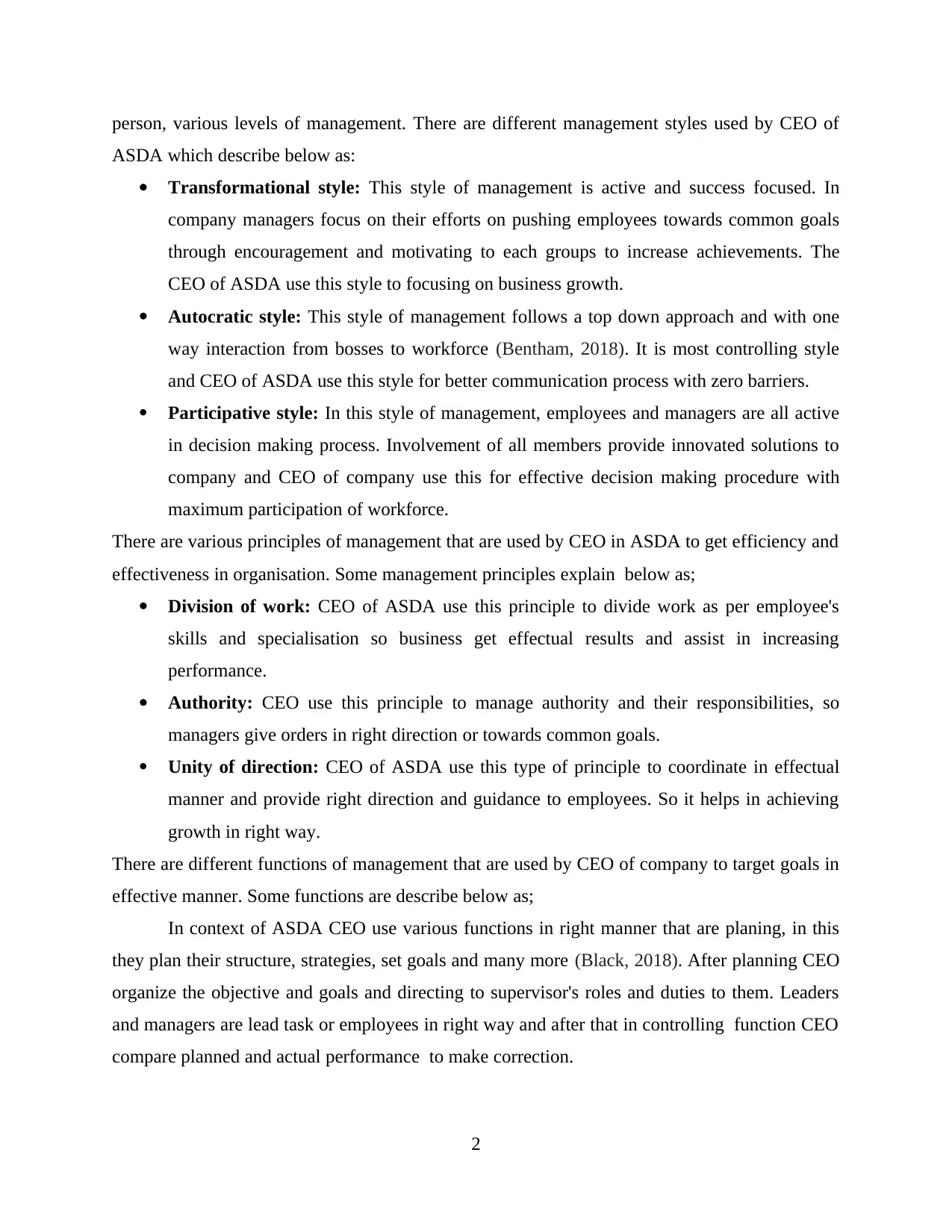
person, various levels of management. There are different management styles used by CEO of
ASDA which describe below as:
Transformational style: This style of management is active and success focused. In
company managers focus on their efforts on pushing employees towards common goals
through encouragement and motivating to each groups to increase achievements. The
CEO of ASDA use this style to focusing on business growth.
Autocratic style: This style of management follows a top down approach and with one
way interaction from bosses to workforce (Bentham, 2018). It is most controlling style
and CEO of ASDA use this style for better communication process with zero barriers.
Participative style: In this style of management, employees and managers are all active
in decision making process. Involvement of all members provide innovated solutions to
company and CEO of company use this for effective decision making procedure with
maximum participation of workforce.
There are various principles of management that are used by CEO in ASDA to get efficiency and
effectiveness in organisation. Some management principles explain below as;
Division of work: CEO of ASDA use this principle to divide work as per employee's
skills and specialisation so business get effectual results and assist in increasing
performance.
Authority: CEO use this principle to manage authority and their responsibilities, so
managers give orders in right direction or towards common goals.
Unity of direction: CEO of ASDA use this type of principle to coordinate in effectual
manner and provide right direction and guidance to employees. So it helps in achieving
growth in right way.
There are different functions of management that are used by CEO of company to target goals in
effective manner. Some functions are describe below as;
In context of ASDA CEO use various functions in right manner that are planing, in this
they plan their structure, strategies, set goals and many more (Black, 2018). After planning CEO
organize the objective and goals and directing to supervisor's roles and duties to them. Leaders
and managers are lead task or employees in right way and after that in controlling function CEO
compare planned and actual performance to make correction.
2
ASDA which describe below as:
Transformational style: This style of management is active and success focused. In
company managers focus on their efforts on pushing employees towards common goals
through encouragement and motivating to each groups to increase achievements. The
CEO of ASDA use this style to focusing on business growth.
Autocratic style: This style of management follows a top down approach and with one
way interaction from bosses to workforce (Bentham, 2018). It is most controlling style
and CEO of ASDA use this style for better communication process with zero barriers.
Participative style: In this style of management, employees and managers are all active
in decision making process. Involvement of all members provide innovated solutions to
company and CEO of company use this for effective decision making procedure with
maximum participation of workforce.
There are various principles of management that are used by CEO in ASDA to get efficiency and
effectiveness in organisation. Some management principles explain below as;
Division of work: CEO of ASDA use this principle to divide work as per employee's
skills and specialisation so business get effectual results and assist in increasing
performance.
Authority: CEO use this principle to manage authority and their responsibilities, so
managers give orders in right direction or towards common goals.
Unity of direction: CEO of ASDA use this type of principle to coordinate in effectual
manner and provide right direction and guidance to employees. So it helps in achieving
growth in right way.
There are different functions of management that are used by CEO of company to target goals in
effective manner. Some functions are describe below as;
In context of ASDA CEO use various functions in right manner that are planing, in this
they plan their structure, strategies, set goals and many more (Black, 2018). After planning CEO
organize the objective and goals and directing to supervisor's roles and duties to them. Leaders
and managers are lead task or employees in right way and after that in controlling function CEO
compare planned and actual performance to make correction.
2
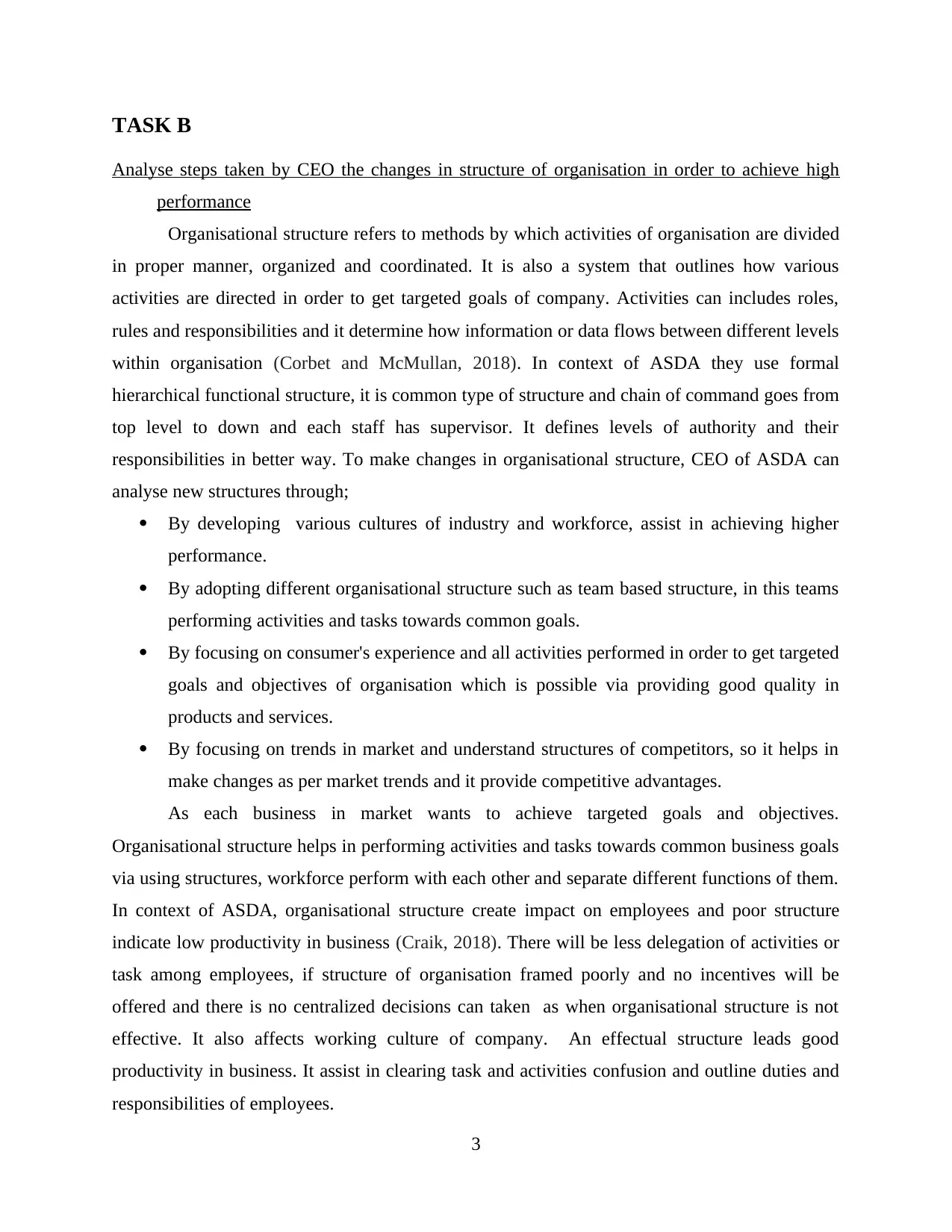
TASK B
Analyse steps taken by CEO the changes in structure of organisation in order to achieve high
performance
Organisational structure refers to methods by which activities of organisation are divided
in proper manner, organized and coordinated. It is also a system that outlines how various
activities are directed in order to get targeted goals of company. Activities can includes roles,
rules and responsibilities and it determine how information or data flows between different levels
within organisation (Corbet and McMullan, 2018). In context of ASDA they use formal
hierarchical functional structure, it is common type of structure and chain of command goes from
top level to down and each staff has supervisor. It defines levels of authority and their
responsibilities in better way. To make changes in organisational structure, CEO of ASDA can
analyse new structures through;
By developing various cultures of industry and workforce, assist in achieving higher
performance.
By adopting different organisational structure such as team based structure, in this teams
performing activities and tasks towards common goals.
By focusing on consumer's experience and all activities performed in order to get targeted
goals and objectives of organisation which is possible via providing good quality in
products and services.
By focusing on trends in market and understand structures of competitors, so it helps in
make changes as per market trends and it provide competitive advantages.
As each business in market wants to achieve targeted goals and objectives.
Organisational structure helps in performing activities and tasks towards common business goals
via using structures, workforce perform with each other and separate different functions of them.
In context of ASDA, organisational structure create impact on employees and poor structure
indicate low productivity in business (Craik, 2018). There will be less delegation of activities or
task among employees, if structure of organisation framed poorly and no incentives will be
offered and there is no centralized decisions can taken as when organisational structure is not
effective. It also affects working culture of company. An effectual structure leads good
productivity in business. It assist in clearing task and activities confusion and outline duties and
responsibilities of employees.
3
Analyse steps taken by CEO the changes in structure of organisation in order to achieve high
performance
Organisational structure refers to methods by which activities of organisation are divided
in proper manner, organized and coordinated. It is also a system that outlines how various
activities are directed in order to get targeted goals of company. Activities can includes roles,
rules and responsibilities and it determine how information or data flows between different levels
within organisation (Corbet and McMullan, 2018). In context of ASDA they use formal
hierarchical functional structure, it is common type of structure and chain of command goes from
top level to down and each staff has supervisor. It defines levels of authority and their
responsibilities in better way. To make changes in organisational structure, CEO of ASDA can
analyse new structures through;
By developing various cultures of industry and workforce, assist in achieving higher
performance.
By adopting different organisational structure such as team based structure, in this teams
performing activities and tasks towards common goals.
By focusing on consumer's experience and all activities performed in order to get targeted
goals and objectives of organisation which is possible via providing good quality in
products and services.
By focusing on trends in market and understand structures of competitors, so it helps in
make changes as per market trends and it provide competitive advantages.
As each business in market wants to achieve targeted goals and objectives.
Organisational structure helps in performing activities and tasks towards common business goals
via using structures, workforce perform with each other and separate different functions of them.
In context of ASDA, organisational structure create impact on employees and poor structure
indicate low productivity in business (Craik, 2018). There will be less delegation of activities or
task among employees, if structure of organisation framed poorly and no incentives will be
offered and there is no centralized decisions can taken as when organisational structure is not
effective. It also affects working culture of company. An effectual structure leads good
productivity in business. It assist in clearing task and activities confusion and outline duties and
responsibilities of employees.
3
⊘ This is a preview!⊘
Do you want full access?
Subscribe today to unlock all pages.

Trusted by 1+ million students worldwide
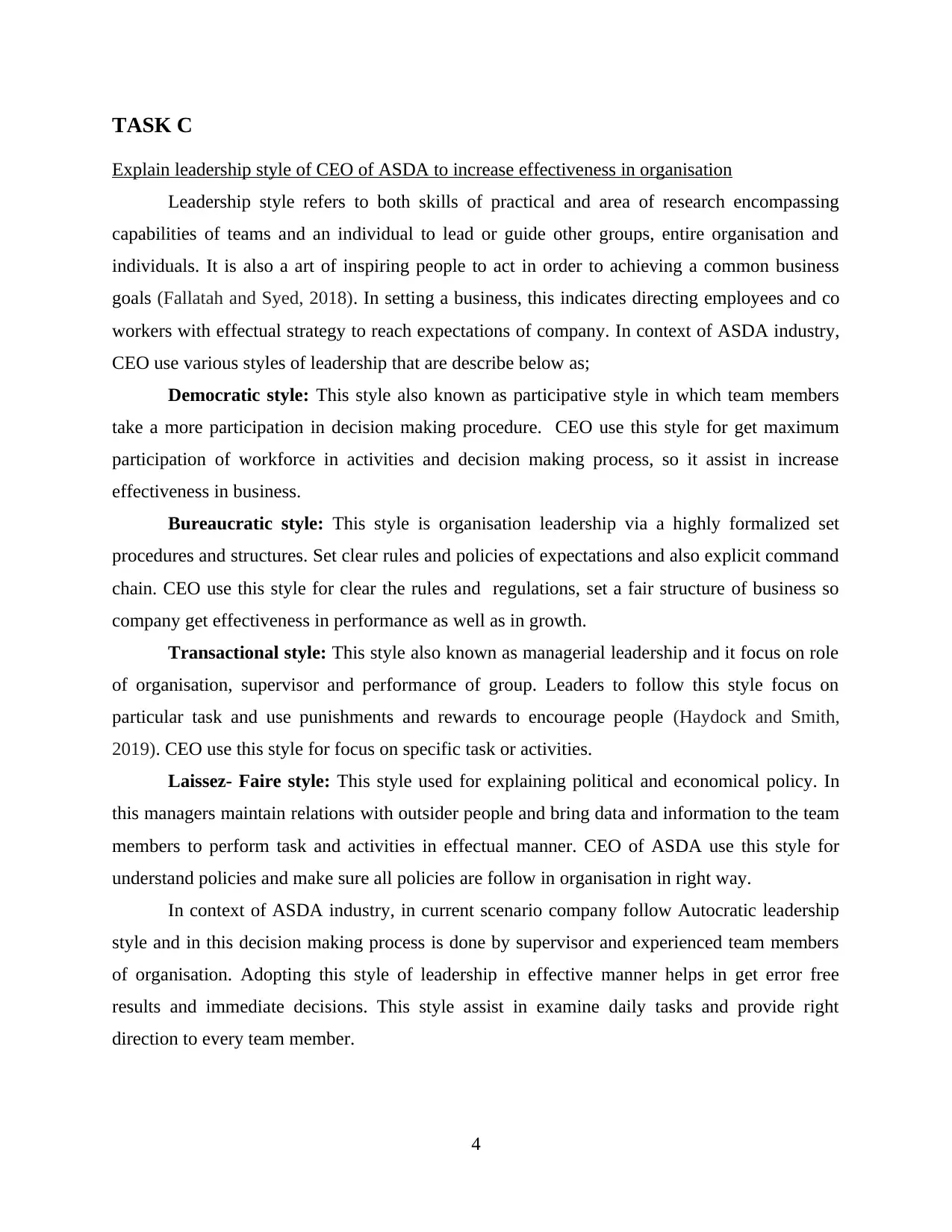
TASK C
Explain leadership style of CEO of ASDA to increase effectiveness in organisation
Leadership style refers to both skills of practical and area of research encompassing
capabilities of teams and an individual to lead or guide other groups, entire organisation and
individuals. It is also a art of inspiring people to act in order to achieving a common business
goals (Fallatah and Syed, 2018). In setting a business, this indicates directing employees and co
workers with effectual strategy to reach expectations of company. In context of ASDA industry,
CEO use various styles of leadership that are describe below as;
Democratic style: This style also known as participative style in which team members
take a more participation in decision making procedure. CEO use this style for get maximum
participation of workforce in activities and decision making process, so it assist in increase
effectiveness in business.
Bureaucratic style: This style is organisation leadership via a highly formalized set
procedures and structures. Set clear rules and policies of expectations and also explicit command
chain. CEO use this style for clear the rules and regulations, set a fair structure of business so
company get effectiveness in performance as well as in growth.
Transactional style: This style also known as managerial leadership and it focus on role
of organisation, supervisor and performance of group. Leaders to follow this style focus on
particular task and use punishments and rewards to encourage people (Haydock and Smith,
2019). CEO use this style for focus on specific task or activities.
Laissez- Faire style: This style used for explaining political and economical policy. In
this managers maintain relations with outsider people and bring data and information to the team
members to perform task and activities in effectual manner. CEO of ASDA use this style for
understand policies and make sure all policies are follow in organisation in right way.
In context of ASDA industry, in current scenario company follow Autocratic leadership
style and in this decision making process is done by supervisor and experienced team members
of organisation. Adopting this style of leadership in effective manner helps in get error free
results and immediate decisions. This style assist in examine daily tasks and provide right
direction to every team member.
4
Explain leadership style of CEO of ASDA to increase effectiveness in organisation
Leadership style refers to both skills of practical and area of research encompassing
capabilities of teams and an individual to lead or guide other groups, entire organisation and
individuals. It is also a art of inspiring people to act in order to achieving a common business
goals (Fallatah and Syed, 2018). In setting a business, this indicates directing employees and co
workers with effectual strategy to reach expectations of company. In context of ASDA industry,
CEO use various styles of leadership that are describe below as;
Democratic style: This style also known as participative style in which team members
take a more participation in decision making procedure. CEO use this style for get maximum
participation of workforce in activities and decision making process, so it assist in increase
effectiveness in business.
Bureaucratic style: This style is organisation leadership via a highly formalized set
procedures and structures. Set clear rules and policies of expectations and also explicit command
chain. CEO use this style for clear the rules and regulations, set a fair structure of business so
company get effectiveness in performance as well as in growth.
Transactional style: This style also known as managerial leadership and it focus on role
of organisation, supervisor and performance of group. Leaders to follow this style focus on
particular task and use punishments and rewards to encourage people (Haydock and Smith,
2019). CEO use this style for focus on specific task or activities.
Laissez- Faire style: This style used for explaining political and economical policy. In
this managers maintain relations with outsider people and bring data and information to the team
members to perform task and activities in effectual manner. CEO of ASDA use this style for
understand policies and make sure all policies are follow in organisation in right way.
In context of ASDA industry, in current scenario company follow Autocratic leadership
style and in this decision making process is done by supervisor and experienced team members
of organisation. Adopting this style of leadership in effective manner helps in get error free
results and immediate decisions. This style assist in examine daily tasks and provide right
direction to every team member.
4
Paraphrase This Document
Need a fresh take? Get an instant paraphrase of this document with our AI Paraphraser
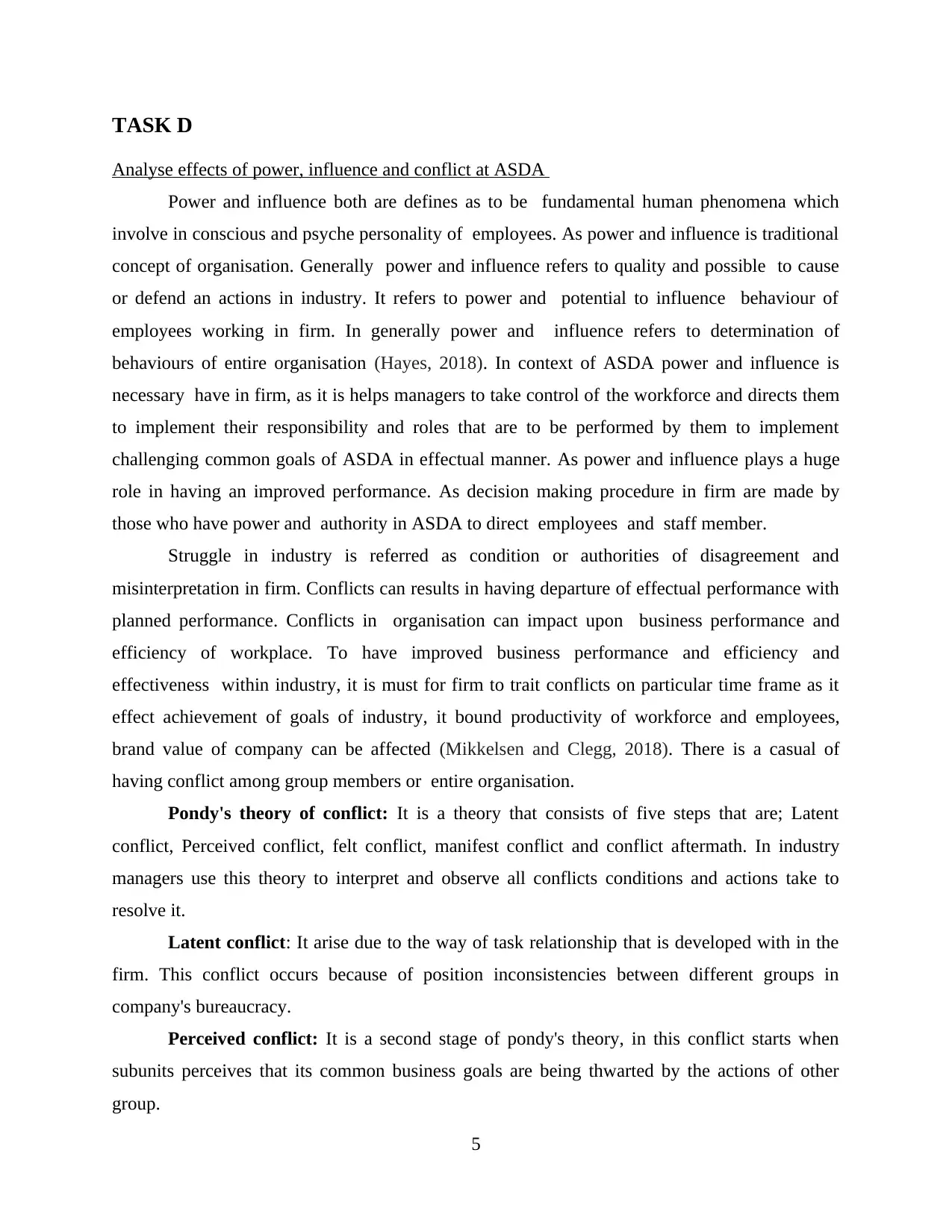
TASK D
Analyse effects of power, influence and conflict at ASDA
Power and influence both are defines as to be fundamental human phenomena which
involve in conscious and psyche personality of employees. As power and influence is traditional
concept of organisation. Generally power and influence refers to quality and possible to cause
or defend an actions in industry. It refers to power and potential to influence behaviour of
employees working in firm. In generally power and influence refers to determination of
behaviours of entire organisation (Hayes, 2018). In context of ASDA power and influence is
necessary have in firm, as it is helps managers to take control of the workforce and directs them
to implement their responsibility and roles that are to be performed by them to implement
challenging common goals of ASDA in effectual manner. As power and influence plays a huge
role in having an improved performance. As decision making procedure in firm are made by
those who have power and authority in ASDA to direct employees and staff member.
Struggle in industry is referred as condition or authorities of disagreement and
misinterpretation in firm. Conflicts can results in having departure of effectual performance with
planned performance. Conflicts in organisation can impact upon business performance and
efficiency of workplace. To have improved business performance and efficiency and
effectiveness within industry, it is must for firm to trait conflicts on particular time frame as it
effect achievement of goals of industry, it bound productivity of workforce and employees,
brand value of company can be affected (Mikkelsen and Clegg, 2018). There is a casual of
having conflict among group members or entire organisation.
Pondy's theory of conflict: It is a theory that consists of five steps that are; Latent
conflict, Perceived conflict, felt conflict, manifest conflict and conflict aftermath. In industry
managers use this theory to interpret and observe all conflicts conditions and actions take to
resolve it.
Latent conflict: It arise due to the way of task relationship that is developed with in the
firm. This conflict occurs because of position inconsistencies between different groups in
company's bureaucracy.
Perceived conflict: It is a second stage of pondy's theory, in this conflict starts when
subunits perceives that its common business goals are being thwarted by the actions of other
group.
5
Analyse effects of power, influence and conflict at ASDA
Power and influence both are defines as to be fundamental human phenomena which
involve in conscious and psyche personality of employees. As power and influence is traditional
concept of organisation. Generally power and influence refers to quality and possible to cause
or defend an actions in industry. It refers to power and potential to influence behaviour of
employees working in firm. In generally power and influence refers to determination of
behaviours of entire organisation (Hayes, 2018). In context of ASDA power and influence is
necessary have in firm, as it is helps managers to take control of the workforce and directs them
to implement their responsibility and roles that are to be performed by them to implement
challenging common goals of ASDA in effectual manner. As power and influence plays a huge
role in having an improved performance. As decision making procedure in firm are made by
those who have power and authority in ASDA to direct employees and staff member.
Struggle in industry is referred as condition or authorities of disagreement and
misinterpretation in firm. Conflicts can results in having departure of effectual performance with
planned performance. Conflicts in organisation can impact upon business performance and
efficiency of workplace. To have improved business performance and efficiency and
effectiveness within industry, it is must for firm to trait conflicts on particular time frame as it
effect achievement of goals of industry, it bound productivity of workforce and employees,
brand value of company can be affected (Mikkelsen and Clegg, 2018). There is a casual of
having conflict among group members or entire organisation.
Pondy's theory of conflict: It is a theory that consists of five steps that are; Latent
conflict, Perceived conflict, felt conflict, manifest conflict and conflict aftermath. In industry
managers use this theory to interpret and observe all conflicts conditions and actions take to
resolve it.
Latent conflict: It arise due to the way of task relationship that is developed with in the
firm. This conflict occurs because of position inconsistencies between different groups in
company's bureaucracy.
Perceived conflict: It is a second stage of pondy's theory, in this conflict starts when
subunits perceives that its common business goals are being thwarted by the actions of other
group.
5
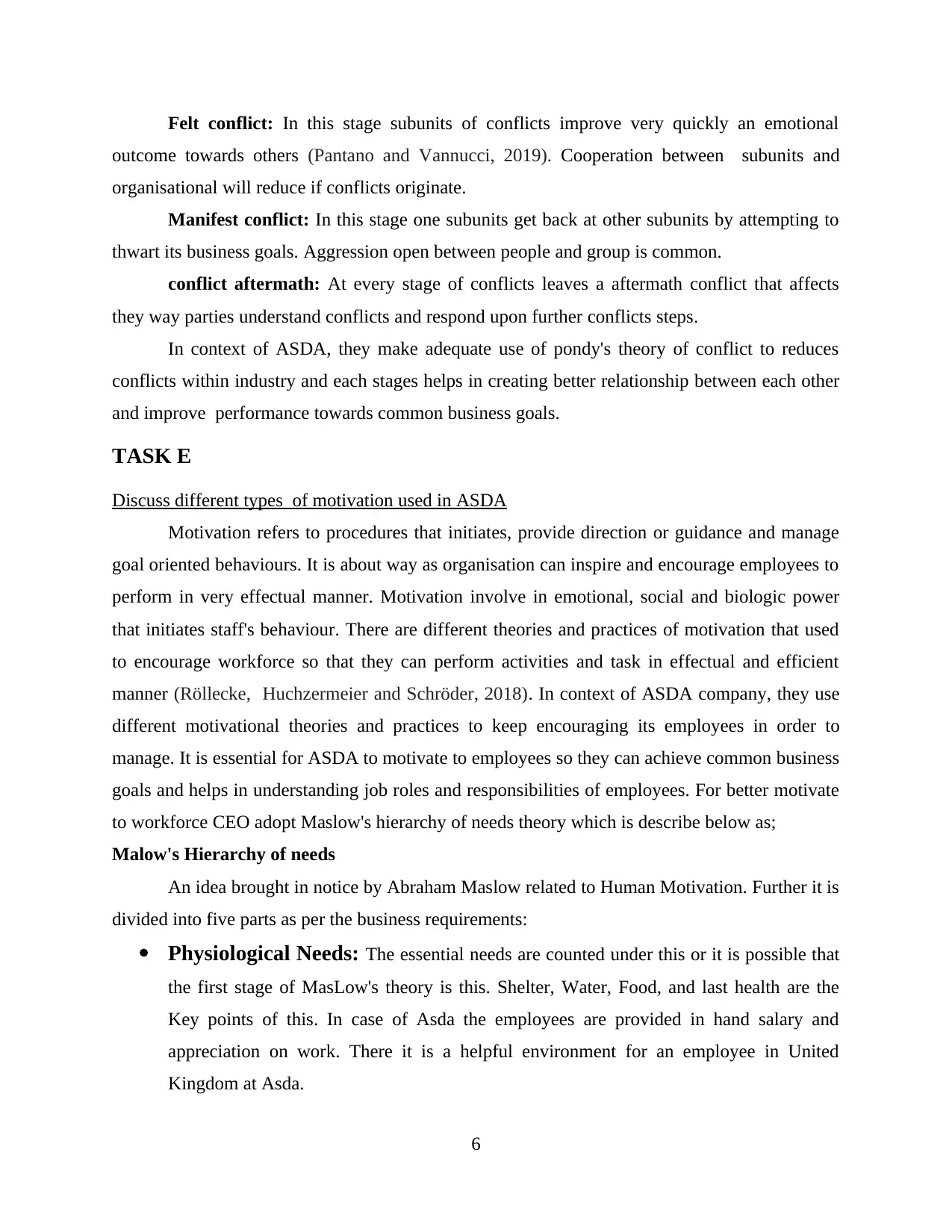
Felt conflict: In this stage subunits of conflicts improve very quickly an emotional
outcome towards others (Pantano and Vannucci, 2019). Cooperation between subunits and
organisational will reduce if conflicts originate.
Manifest conflict: In this stage one subunits get back at other subunits by attempting to
thwart its business goals. Aggression open between people and group is common.
conflict aftermath: At every stage of conflicts leaves a aftermath conflict that affects
they way parties understand conflicts and respond upon further conflicts steps.
In context of ASDA, they make adequate use of pondy's theory of conflict to reduces
conflicts within industry and each stages helps in creating better relationship between each other
and improve performance towards common business goals.
TASK E
Discuss different types of motivation used in ASDA
Motivation refers to procedures that initiates, provide direction or guidance and manage
goal oriented behaviours. It is about way as organisation can inspire and encourage employees to
perform in very effectual manner. Motivation involve in emotional, social and biologic power
that initiates staff's behaviour. There are different theories and practices of motivation that used
to encourage workforce so that they can perform activities and task in effectual and efficient
manner (Röllecke, Huchzermeier and Schröder, 2018). In context of ASDA company, they use
different motivational theories and practices to keep encouraging its employees in order to
manage. It is essential for ASDA to motivate to employees so they can achieve common business
goals and helps in understanding job roles and responsibilities of employees. For better motivate
to workforce CEO adopt Maslow's hierarchy of needs theory which is describe below as;
Malow's Hierarchy of needs
An idea brought in notice by Abraham Maslow related to Human Motivation. Further it is
divided into five parts as per the business requirements:
Physiological Needs: The essential needs are counted under this or it is possible that
the first stage of MasLow's theory is this. Shelter, Water, Food, and last health are the
Key points of this. In case of Asda the employees are provided in hand salary and
appreciation on work. There it is a helpful environment for an employee in United
Kingdom at Asda.
6
outcome towards others (Pantano and Vannucci, 2019). Cooperation between subunits and
organisational will reduce if conflicts originate.
Manifest conflict: In this stage one subunits get back at other subunits by attempting to
thwart its business goals. Aggression open between people and group is common.
conflict aftermath: At every stage of conflicts leaves a aftermath conflict that affects
they way parties understand conflicts and respond upon further conflicts steps.
In context of ASDA, they make adequate use of pondy's theory of conflict to reduces
conflicts within industry and each stages helps in creating better relationship between each other
and improve performance towards common business goals.
TASK E
Discuss different types of motivation used in ASDA
Motivation refers to procedures that initiates, provide direction or guidance and manage
goal oriented behaviours. It is about way as organisation can inspire and encourage employees to
perform in very effectual manner. Motivation involve in emotional, social and biologic power
that initiates staff's behaviour. There are different theories and practices of motivation that used
to encourage workforce so that they can perform activities and task in effectual and efficient
manner (Röllecke, Huchzermeier and Schröder, 2018). In context of ASDA company, they use
different motivational theories and practices to keep encouraging its employees in order to
manage. It is essential for ASDA to motivate to employees so they can achieve common business
goals and helps in understanding job roles and responsibilities of employees. For better motivate
to workforce CEO adopt Maslow's hierarchy of needs theory which is describe below as;
Malow's Hierarchy of needs
An idea brought in notice by Abraham Maslow related to Human Motivation. Further it is
divided into five parts as per the business requirements:
Physiological Needs: The essential needs are counted under this or it is possible that
the first stage of MasLow's theory is this. Shelter, Water, Food, and last health are the
Key points of this. In case of Asda the employees are provided in hand salary and
appreciation on work. There it is a helpful environment for an employee in United
Kingdom at Asda.
6
⊘ This is a preview!⊘
Do you want full access?
Subscribe today to unlock all pages.

Trusted by 1+ million students worldwide
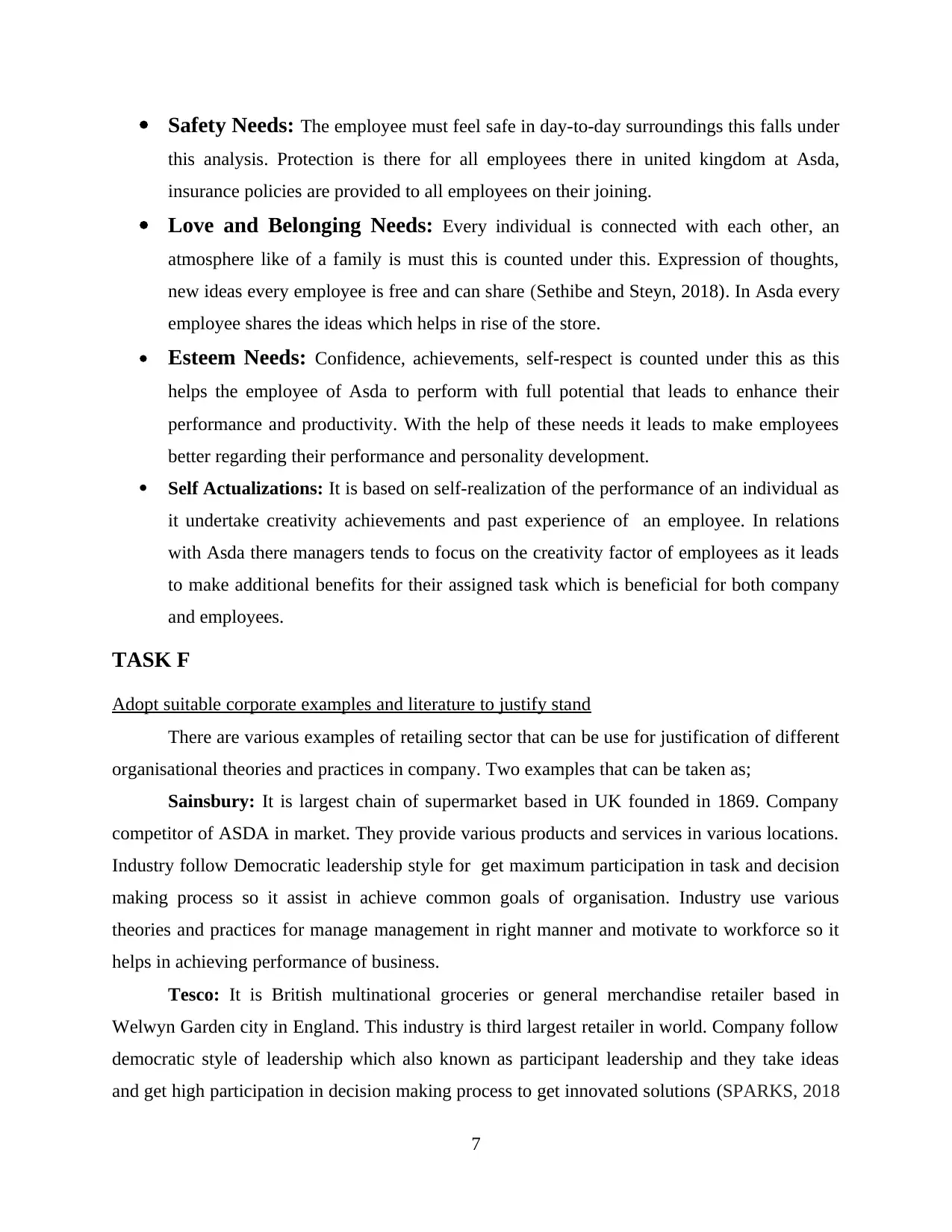
Safety Needs: The employee must feel safe in day-to-day surroundings this falls under
this analysis. Protection is there for all employees there in united kingdom at Asda,
insurance policies are provided to all employees on their joining.
Love and Belonging Needs: Every individual is connected with each other, an
atmosphere like of a family is must this is counted under this. Expression of thoughts,
new ideas every employee is free and can share (Sethibe and Steyn, 2018). In Asda every
employee shares the ideas which helps in rise of the store.
Esteem Needs: Confidence, achievements, self-respect is counted under this as this
helps the employee of Asda to perform with full potential that leads to enhance their
performance and productivity. With the help of these needs it leads to make employees
better regarding their performance and personality development.
Self Actualizations: It is based on self-realization of the performance of an individual as
it undertake creativity achievements and past experience of an employee. In relations
with Asda there managers tends to focus on the creativity factor of employees as it leads
to make additional benefits for their assigned task which is beneficial for both company
and employees.
TASK F
Adopt suitable corporate examples and literature to justify stand
There are various examples of retailing sector that can be use for justification of different
organisational theories and practices in company. Two examples that can be taken as;
Sainsbury: It is largest chain of supermarket based in UK founded in 1869. Company
competitor of ASDA in market. They provide various products and services in various locations.
Industry follow Democratic leadership style for get maximum participation in task and decision
making process so it assist in achieve common goals of organisation. Industry use various
theories and practices for manage management in right manner and motivate to workforce so it
helps in achieving performance of business.
Tesco: It is British multinational groceries or general merchandise retailer based in
Welwyn Garden city in England. This industry is third largest retailer in world. Company follow
democratic style of leadership which also known as participant leadership and they take ideas
and get high participation in decision making process to get innovated solutions (SPARKS, 2018
7
this analysis. Protection is there for all employees there in united kingdom at Asda,
insurance policies are provided to all employees on their joining.
Love and Belonging Needs: Every individual is connected with each other, an
atmosphere like of a family is must this is counted under this. Expression of thoughts,
new ideas every employee is free and can share (Sethibe and Steyn, 2018). In Asda every
employee shares the ideas which helps in rise of the store.
Esteem Needs: Confidence, achievements, self-respect is counted under this as this
helps the employee of Asda to perform with full potential that leads to enhance their
performance and productivity. With the help of these needs it leads to make employees
better regarding their performance and personality development.
Self Actualizations: It is based on self-realization of the performance of an individual as
it undertake creativity achievements and past experience of an employee. In relations
with Asda there managers tends to focus on the creativity factor of employees as it leads
to make additional benefits for their assigned task which is beneficial for both company
and employees.
TASK F
Adopt suitable corporate examples and literature to justify stand
There are various examples of retailing sector that can be use for justification of different
organisational theories and practices in company. Two examples that can be taken as;
Sainsbury: It is largest chain of supermarket based in UK founded in 1869. Company
competitor of ASDA in market. They provide various products and services in various locations.
Industry follow Democratic leadership style for get maximum participation in task and decision
making process so it assist in achieve common goals of organisation. Industry use various
theories and practices for manage management in right manner and motivate to workforce so it
helps in achieving performance of business.
Tesco: It is British multinational groceries or general merchandise retailer based in
Welwyn Garden city in England. This industry is third largest retailer in world. Company follow
democratic style of leadership which also known as participant leadership and they take ideas
and get high participation in decision making process to get innovated solutions (SPARKS, 2018
7
Paraphrase This Document
Need a fresh take? Get an instant paraphrase of this document with our AI Paraphraser
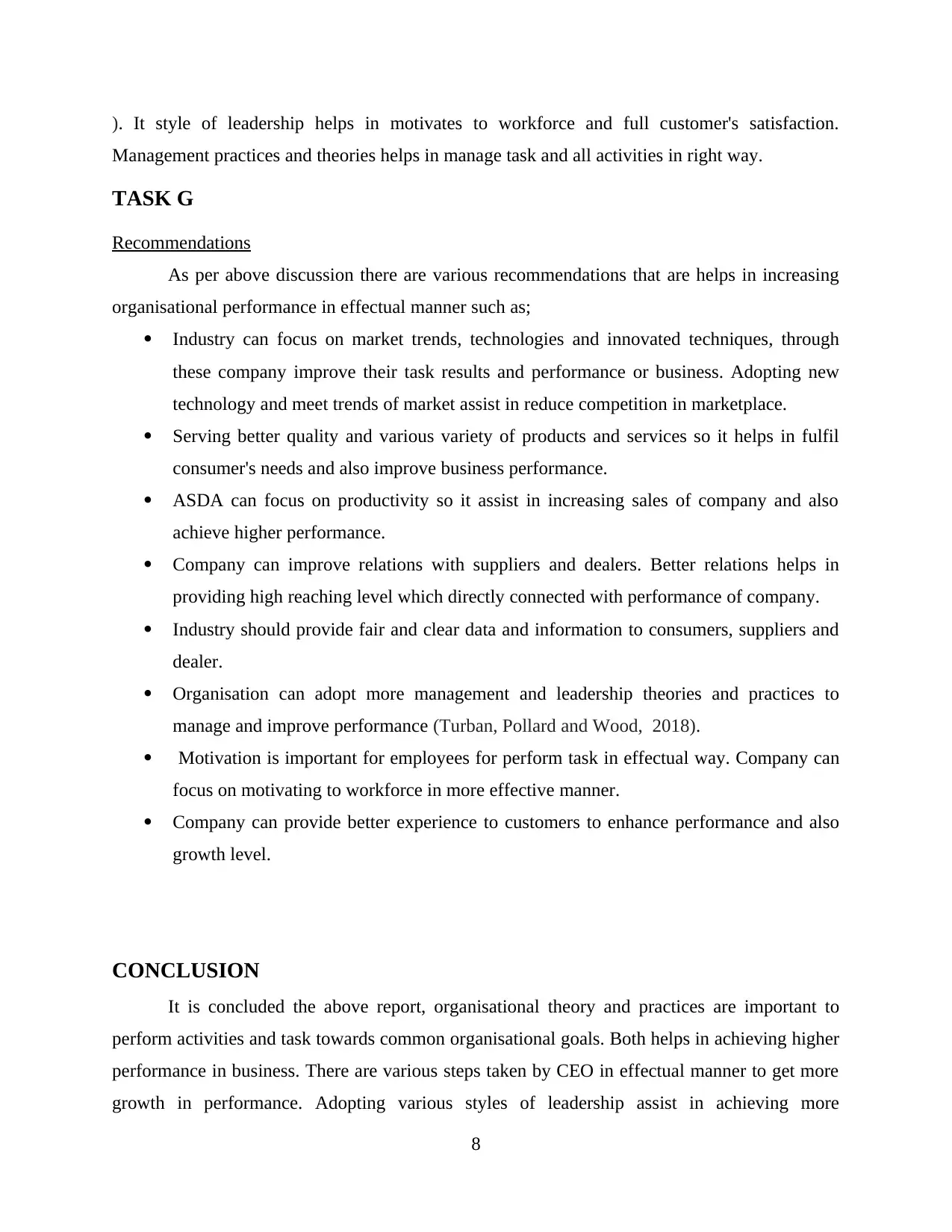
). It style of leadership helps in motivates to workforce and full customer's satisfaction.
Management practices and theories helps in manage task and all activities in right way.
TASK G
Recommendations
As per above discussion there are various recommendations that are helps in increasing
organisational performance in effectual manner such as;
Industry can focus on market trends, technologies and innovated techniques, through
these company improve their task results and performance or business. Adopting new
technology and meet trends of market assist in reduce competition in marketplace.
Serving better quality and various variety of products and services so it helps in fulfil
consumer's needs and also improve business performance.
ASDA can focus on productivity so it assist in increasing sales of company and also
achieve higher performance.
Company can improve relations with suppliers and dealers. Better relations helps in
providing high reaching level which directly connected with performance of company.
Industry should provide fair and clear data and information to consumers, suppliers and
dealer.
Organisation can adopt more management and leadership theories and practices to
manage and improve performance (Turban, Pollard and Wood, 2018).
Motivation is important for employees for perform task in effectual way. Company can
focus on motivating to workforce in more effective manner.
Company can provide better experience to customers to enhance performance and also
growth level.
CONCLUSION
It is concluded the above report, organisational theory and practices are important to
perform activities and task towards common organisational goals. Both helps in achieving higher
performance in business. There are various steps taken by CEO in effectual manner to get more
growth in performance. Adopting various styles of leadership assist in achieving more
8
Management practices and theories helps in manage task and all activities in right way.
TASK G
Recommendations
As per above discussion there are various recommendations that are helps in increasing
organisational performance in effectual manner such as;
Industry can focus on market trends, technologies and innovated techniques, through
these company improve their task results and performance or business. Adopting new
technology and meet trends of market assist in reduce competition in marketplace.
Serving better quality and various variety of products and services so it helps in fulfil
consumer's needs and also improve business performance.
ASDA can focus on productivity so it assist in increasing sales of company and also
achieve higher performance.
Company can improve relations with suppliers and dealers. Better relations helps in
providing high reaching level which directly connected with performance of company.
Industry should provide fair and clear data and information to consumers, suppliers and
dealer.
Organisation can adopt more management and leadership theories and practices to
manage and improve performance (Turban, Pollard and Wood, 2018).
Motivation is important for employees for perform task in effectual way. Company can
focus on motivating to workforce in more effective manner.
Company can provide better experience to customers to enhance performance and also
growth level.
CONCLUSION
It is concluded the above report, organisational theory and practices are important to
perform activities and task towards common organisational goals. Both helps in achieving higher
performance in business. There are various steps taken by CEO in effectual manner to get more
growth in performance. Adopting various styles of leadership assist in achieving more
8
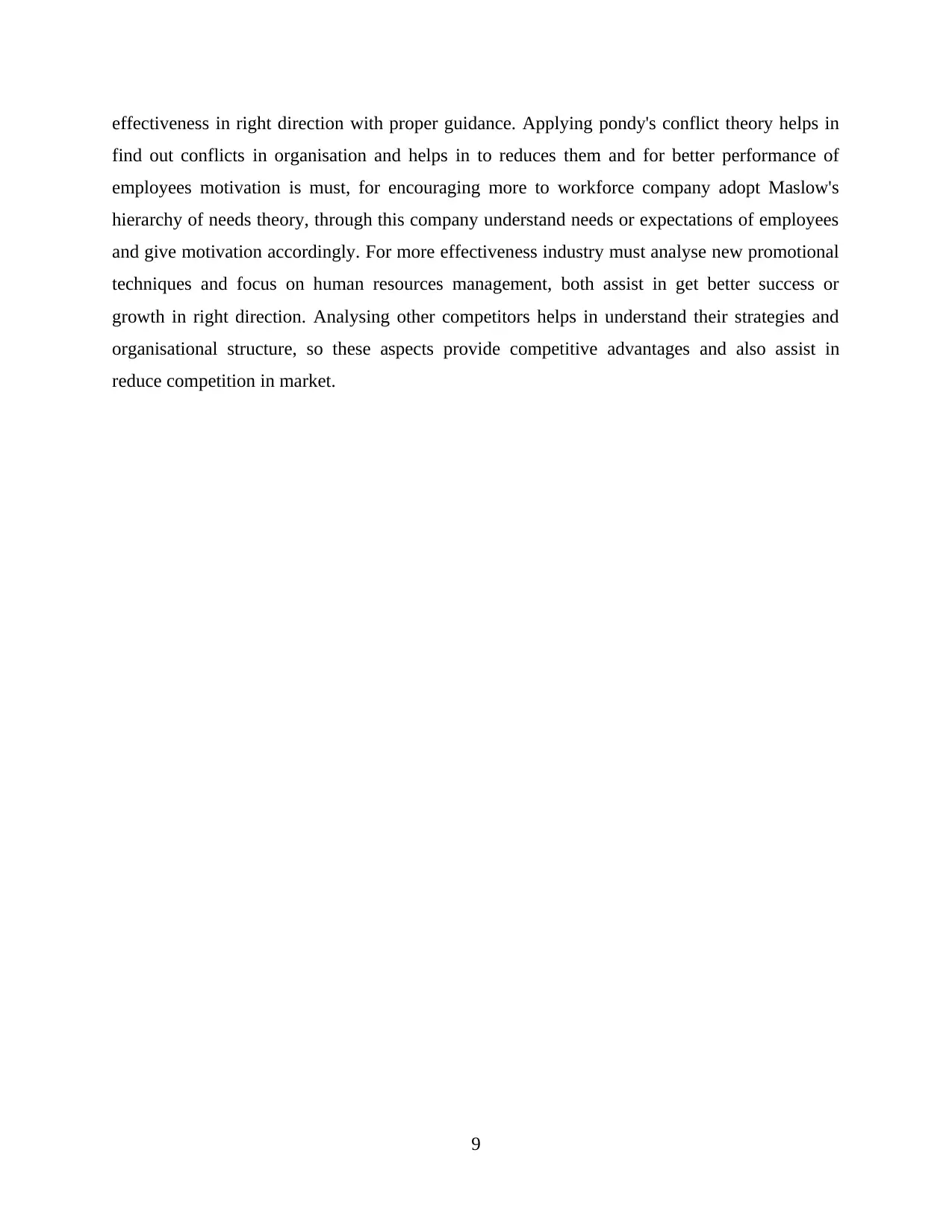
effectiveness in right direction with proper guidance. Applying pondy's conflict theory helps in
find out conflicts in organisation and helps in to reduces them and for better performance of
employees motivation is must, for encouraging more to workforce company adopt Maslow's
hierarchy of needs theory, through this company understand needs or expectations of employees
and give motivation accordingly. For more effectiveness industry must analyse new promotional
techniques and focus on human resources management, both assist in get better success or
growth in right direction. Analysing other competitors helps in understand their strategies and
organisational structure, so these aspects provide competitive advantages and also assist in
reduce competition in market.
9
find out conflicts in organisation and helps in to reduces them and for better performance of
employees motivation is must, for encouraging more to workforce company adopt Maslow's
hierarchy of needs theory, through this company understand needs or expectations of employees
and give motivation accordingly. For more effectiveness industry must analyse new promotional
techniques and focus on human resources management, both assist in get better success or
growth in right direction. Analysing other competitors helps in understand their strategies and
organisational structure, so these aspects provide competitive advantages and also assist in
reduce competition in market.
9
⊘ This is a preview!⊘
Do you want full access?
Subscribe today to unlock all pages.

Trusted by 1+ million students worldwide
1 out of 13
Related Documents
Your All-in-One AI-Powered Toolkit for Academic Success.
+13062052269
info@desklib.com
Available 24*7 on WhatsApp / Email
![[object Object]](/_next/static/media/star-bottom.7253800d.svg)
Unlock your academic potential
Copyright © 2020–2025 A2Z Services. All Rights Reserved. Developed and managed by ZUCOL.





